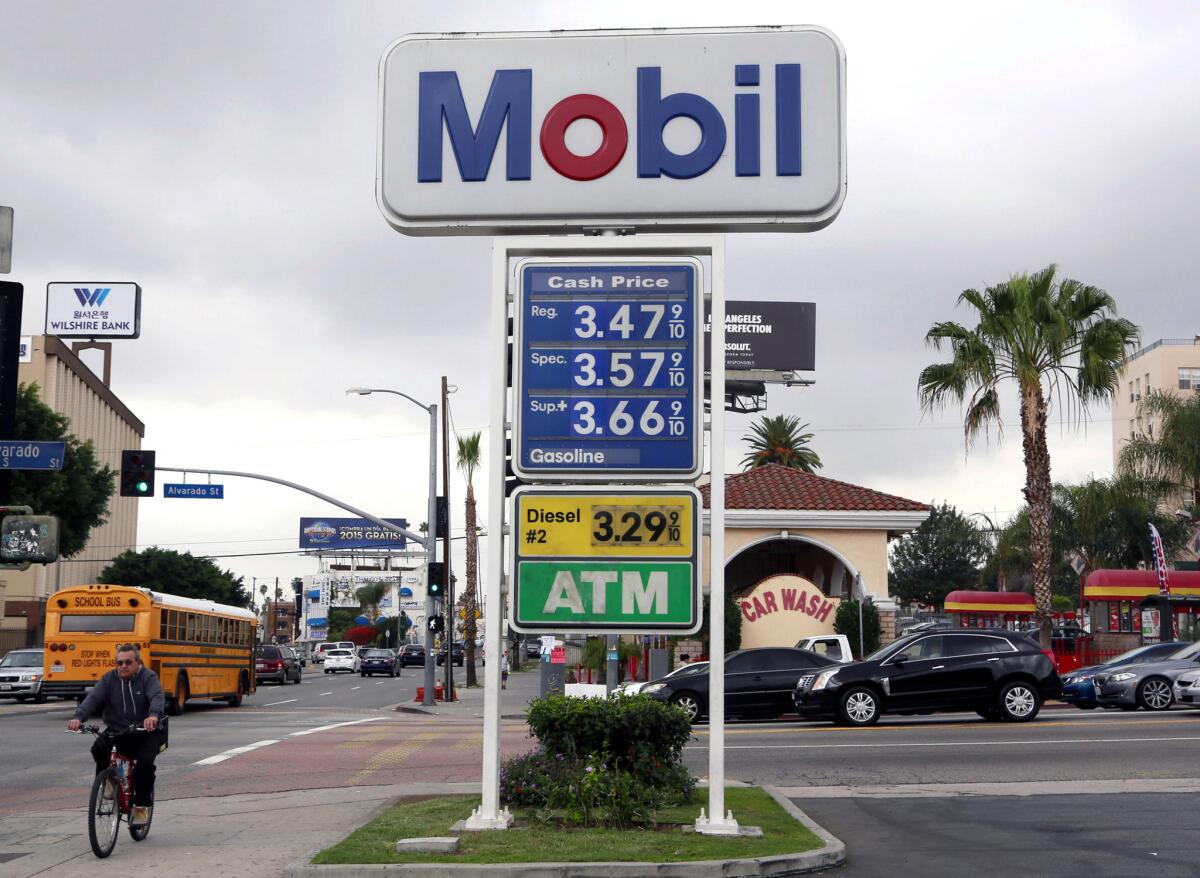California gasoline prices jump because of refinery issues

Sign at a gas station in Los Angeles in happier times, gas-price-wise.
To deal with the surging price of gasoline, Chenni Kaur has developed a strategy: If low on fuel near her job in downtown Los Angeles, the Sunland resident buys only a few gallons so that she can get home where prices are a little cheaper.
Still, Kaur said, she is spending as much as $80 a week to fill her Toyota Sienna van, up from about $50 or $60 a few months ago. That extra money has to come from other parts of her family’s budget because a 21/2-hour bus ride from home to work isn’t feasible, she said.
“We’re cutting down a little bit on groceries,” said Kaur, 36. “We are managing our money so we can manage our gas.”
The average cost for a gallon of regular in California was $3.532 on Thursday, up from $3.194 a week earlier, according to AAA. The average price jumped 6 cents from Wednesday.
The swift rise, experts say, is because of problems at some refineries in the state. Prices are up nationwide after a rebound in crude prices, but nowhere is the jump as severe as in the Golden State.
California refineries often produce gasoline at near capacity, leaving little margin for supply disruptions. And the state’s special cleaner-burning blend is expensive for outsiders to make and deliver, causing most production to occur within the state.
“Our margin of error is very small,” said Allison Mac, an analyst with price-tracking website GasBuddy. “When something happens, it could send prices way up.”
The recent increase has drivers longing for prices of just a few weeks ago.
Maria Madera figures she is shelling out $20 more for a full tank than a month ago. To make up the difference, she said, she’s eating out less.
“A month ago ... I was so happy — $40 and the tank was already full,” the 30-year-old Los Angeles resident said while filling up at a Shell station in Boyle Heights, where a gallon of regular gasoline cost $3.79 on Thursday for those paying cash.
The state has been grappling with tight supply after a February explosion at Exxon Mobil Corp.’s Torrance refinery, analysts said. Oil Price Information Service, an energy information service, reported it might take until July before operations there return to normal.
An Exxon Mobil spokeswoman said the company doesn’t comment on the details of daily refinery operations. Last week, Chevron Corp.’s Richmond refinery reported it was flaring, and Tesoro Corp. indicated it was experiencing minor issues at its Martinez refinery, according to GasBuddy. The incidents trimmed output, worried traders and sent wholesale prices shooting up, Mac said.
Tesoro is also undergoing unplanned maintenance work to solve a problem at its Los Angeles facility, said Brian L. Milne, an energy editor with Schneider Electric. Chevron has shut some units in El Segundo for planned maintenance work, Milne said.
If supply is disrupted, facilities must still fulfill long-term contracts to their customers, such as gas stations. So for a quick fix, they draw from their slim inventories and try to buy gasoline from traders and other local refineries.
Oil Price Information Service reported Wednesday that Chevron had emerged as a buyer on the California gas market and that some traders were not aware maintenance was coming in El Segundo.
Chevron said it doesn’t comment on refinery operations. Tesoro spokeswoman Tina Barbee said operations were continuing during its Los Angeles maintenance.
“We do not anticipate any impact upon our ability to meet customer supply commitments,” she said in an email. She did not respond to questions about the Martinez refinery.
Tom Kloza, oil analyst for OPIS, said refinery goings-on are seen and treated as trade secrets, so any action by oil companies can cause a “pop” in the market.
“There’s a few big companies that if all of a sudden they’re seen buying aggressively in the market, it’s going to prompt speculations like, ‘Oh, they’re having problems,’” he said.
Jamie Court, president of Consumer Watchdog, a Santa Monica advocacy group, said refineries should be forced to report about outages. With more information about problems and how long they may last, there would be less speculation among traders — and thus less pain at the pump for California drivers, he said.
“This market is a black box where no one knows what’s down or up,” Court said, placing the blame for the big jump from Wednesday on Chevron’s reported buying on the spot market. Milne said he anticipates prices will peak in May, then decline through the summer as refineries work through their issues.
Despite the recent jump, a global oil glut has held prices below their level this time last year, when California drivers on average paid $4.263 for a gallon of regular, according to AAA.
For now, drivers are in for a shock. Mariana Lake looked toward the price sign at a Chevron near Union Station before paying at the pump. The price of regular: $4.89 a gallon.
She gasped. Then the Baldwin Park resident started pumping, but stopped at $10.
Twitter: @smasunaga, @khouriandrew
More to Read
Inside the business of entertainment
The Wide Shot brings you news, analysis and insights on everything from streaming wars to production — and what it all means for the future.
You may occasionally receive promotional content from the Los Angeles Times.












